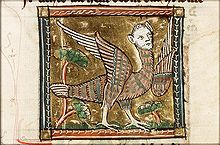Harpies
In Greek mythology, the harpies or harpies (in ancient Greek Ἇρπυια Hárpyia, 'that flies and loots') were initially beings with the appearance of beautiful winged women, whose main task was to enforce the punishment imposed by Zeus on Fineo: using their ability to fly, they continually stole his food before he could take it. This led them to fight against the Argonauts.
In later traditions they were transformed into evil geniuses with the body of a bird of prey, the hideous face of a woman, the ears of a bear and sharp claws, who brought storms, plagues and misfortune with them. This is the form that ended up being imposed and that has lasted until today.
Mythology
The Harpies were daughters of Electra and Thaumante, and sisters of Iris and Arce. Hesiod describes them in his Theogony as creatures with "adorable hair", which is in keeping with their originally beautiful appearance.
His defining myth is tied to Phineus, king of Thrace who had the gift of prophecy. Zeus, furious with him for having revealed secrets of the Olympian gods without consent, punished him by confining him to an island with a feast of which he could eat nothing, for the Harpies always stole the food from his hands just before he could take it. This punishment lasted until the arrival of Jason and the Argonauts, who sent the winged heroes Calais and Zetes, the Boréads, after the Harpies. These managed to scare them away, but they did not kill them at the request of Iris, who promised that Fineo would not be bothered again. Grateful for his help, Phineus told the Argonauts how to overcome the Symplegades in order to continue his journey.
Over time, new details were added to the basic version of this myth: the Harpies no longer stole the food but soiled it with their excrement, corrupting it. Soon they began to be seen as spreaders of filth and disease, thus acquiring their most famous monstrous appearance.
In this new guise they were also doers of punishment, kidnapping people and torturing them on their way to Tartarus in a diffuse overlap with the Erinyes. They were ruthless, cruel and violent, and they lived on the Estrofades Islands. They were considered personifications of the destructive nature of the wind.
According to Hesiod, there were originally two Harpies: Aelo ('stormy wind', sometimes called Nicotoe) and Ocípete ('fast flight'). Later the Romans added Celeno ('the dark one'), the most evil of all. Homer names in the Iliad another named Podarge ('swift feet'), mother of Xanthus and Balio (Achilles' horses) after uniting with the Zephyr wind. The Harpies are also made mothers of Flógeo and Hárpago, horses of the Dioscuri (Castor and Pollux).
Aeneas ran into the Harpies when he docked at the Strophades on his way to Italy, repeatedly stealing the banquet that the Trojans were preparing. Celeno cursed them saying that they would end up so hungry that they would devour their tables before the day was over. The Trojans fled in fright.
Theories about its origin
R. D. Barnett suggests in Ancient Oriental Influences in Archaic Greece (an essay in The Aegean and Near East, ed. Saul S. Weinberg, Locust Valley, New York, 1956) that the iconography of the Harpies was adapted ab initio from the ornaments on the bronze cauldrons of Urartu. In them you can see birds with female faces:
These [the boilers and their representations] caused such an impression in Greece that they seem to have driven the boom of the mermaids in the Greek archaic art, and as these seemed to revoke on the edge of such noble vessels of cuisine, originated the familiar Greek legend of Fineo and the Harpías, who are also represented in Greek art. The same name of Fineo, the victim of his persecutions, may be but a corruption of the name of a king of Urartu, Ishpuinish or Ushpina (about 820 BC), who might be related by the Greek merchants to these vessels.
Iconography
Initially, the Harpies were represented in the form of winged maidens. Later, in Roman times, they are represented as birds with the head of a woman, an image similar to that of mermaids. The latter is the image of the Harpies that has prevailed from then until today.
Heraldry
In the Middle Ages, the harpy, often called the "virgin eagle", became a popular charge in heraldry, particularly in East Frisia, appearing among others on the Rietberg, Liechtenstein and house coats of arms Criksena.
Fonts
- Pseudo-Apolodoro: Mythological Library, I, 2, 6; I, 9, 21 and 22.
- I, 2, 6.
- English text, with electronic index, in the Perseus Project; ed. of 1921 by James George Frazer. At the top right are the active labels "focus"(to change the Greek text) and "load" (for the bilingual text).
- I, 2, 6: Greek text in Wikisource.
- English text, with electronic index, in the Perseus Project; ed. of 1921 by James George Frazer. At the top right are the active labels "focus"(to change the Greek text) and "load" (for the bilingual text).
- I, 9, 21 and 22.
- I, 9, 20 and 22: French text.
- English text, with electronic index, in the Perseus Project; ed. of 1921 by James George Frazer: 21; 22. At the top right are the active labels "focus"(to change the Greek text) and "load" (for the bilingual text).
- Greek text on Wikisource: I, 9, 21; I, 9, 22.
- English text, with electronic index, in the Perseus Project; ed. of 1921 by James George Frazer: 21; 22. At the top right are the active labels "focus"(to change the Greek text) and "load" (for the bilingual text).
- I, 9, 20 and 22: French text.
- I, 2, 6.
Contenido relacionado
Sorgina
Kámala
Syrinx (mythology)

